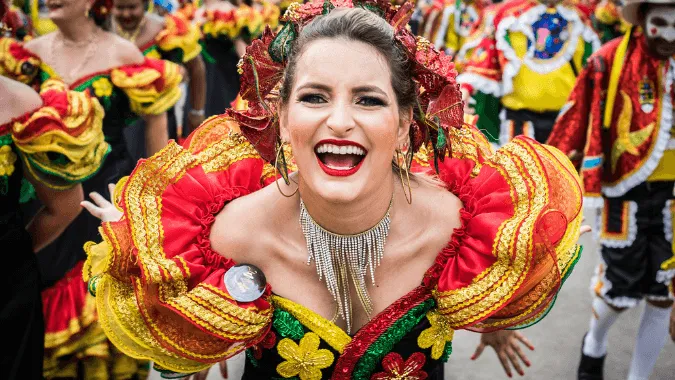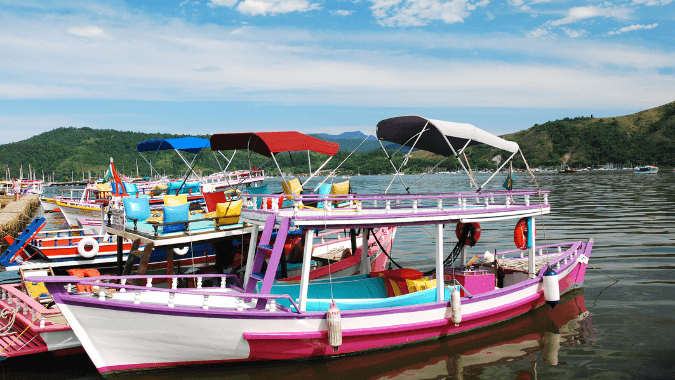How to Celebrate New Year’s Eve in Rio de Janeiro
New Year's Eve in Rio de Janeiro is the most renowned in the whole world, as well as being one of the most important celebrations for the city’s residents, second only to Rio Carnival. For this reason, New Year’s Eve, or Réveillon, is celebrated in true style all over the city. Millions of people flock to the beaches where extravagant parties are held, fireworks light up the sky over Copacabana, live shows take place and copious amounts of champagne is consumed. In addition to these lavish celebrations, the city’s residents show their gratitude and respect to Iemanjá, the goddess of sea water, in a festival which coincides with the start of the New Year.
[caption id="attachment_979" align="aligncenter" width="540"] Celebrate New Year's Eve in Rio de Janeiro from Copacabana / source[/caption]
Celebrate New Year's Eve in Rio de Janeiro from Copacabana / source[/caption] Festa de Iemanjá: giving thanks to the goddess of sea water
Festa de Iemanjá is a highly significant cultural celebration in Rio de Janeiro, whereby believers of the goddess gather early in the morning on New Year's day for a procession in her name. All dressed in white, they walk with Iemanjá’s statue, taking with them flowers and other such offerings which they either place in small boats or launch into the sea. These gifts are presented to the goddess to show thanks for the year that has passed and hope of happiness for the year to come.
[caption id="attachment_7929" align="alignnone" width="702"] People offering gifts to Iemanjá / source[/caption]
People offering gifts to Iemanjá / source[/caption] Iemanjá belongs to the religion Camdomblé, a Brazilian-African hybrid religion born in times of slavery. The celebrations reportedly came about in Bahia in 1923, when a lack of fish in the sea encouraged fisherman to please the goddess in the hope of being rewarded with more. Although nowadays Festa de Iemanjá is predominantly celebrated in Bahia, followers of the religion in Rio de Janeiro have too been celebrating in recent years.
According to believers of Camdomblé, Iemanjá represents peace and strength and opens paths to everything good in life. When the flowers and gifts, which usually consist of feminine objects such as perfume, candles, make-up and jewellery, are thrown her way, they are either carried away on the ocean’s current, a sign that the goddess is satisfied, or return to shore, revealing that the prayers of those believers will not be answered.
Other New Year’s Eve traditions in Rio de Janeiro
As well as these offerings to the sea, there are several other traditions that play an important role on New Year’s Eve in Rio de Janeiro. In terms of clothing, white is the base colour for any outfit, as it signifies peace. On top of this, you can wear green for good health, yellow for wealth, red to attract passion and romance, and purple for inspiration. Where food is concerned, lentils are an important staple as they signify health, and pork and fish are popular food choices, for these symbolise moving forward. At midnight, you have to eat seven pieces of raisins, but leave the seeds and keep these in your wallet to increase your money flow. When making your New Year’s wishes, jump over seven different waves to ensure that they come true and, if you want to increase your luck in love, make sure that the first person you greet when the New Year comes round is a member of the opposite sex.
[caption id="attachment_982" align="aligncenter" width="540"] Lentils are a lucky New Year's Eve staple in Rio / source[/caption]
Lentils are a lucky New Year's Eve staple in Rio / source[/caption] With all these different ways to welcome in the New Year, you can be sure that that there won’t be a dull moment on New Year’s Eve in Rio de Janeiro!
For more information, or to book tours and activities in Rio de Janeiro, visit our website.
By: Camilla Day - English Content Manager
-
Exciting 4x4 route: São Luís and FortalezafromUS$1,014
-
Vila Gale Mares Resort All InclusivefromUS$100
-
Ecotourism in Chapada DiamantinafromUS$672
-
All inclusive Vila Gelé Cumbuco ResortfromUS$999
-
Full Day Cafayate Tour from SaltafromUS$68
-
Transfer Aeroparque - Buenos AiresfromUS$46
-
-
Transfer Ezeiza - AeroparquefromUS$91
-
-
Excursion to El Chaltén from El CalafatefromUS$153
-
-
-
-
-
-
-
-
-
-
-



